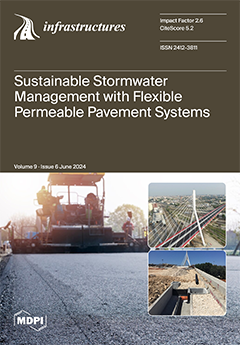The rise in greenhouse gases, particularly carbon dioxide (CO
2) emissions, in the atmosphere is one of the major causes of global warming and climate change. The production of ordinary Portland cement (OPC) emits harmful CO
2 gases, which contribute to sporadic
[...] Read more.
The rise in greenhouse gases, particularly carbon dioxide (CO
2) emissions, in the atmosphere is one of the major causes of global warming and climate change. The production of ordinary Portland cement (OPC) emits harmful CO
2 gases, which contribute to sporadic heatwaves, rapid melting of glaciers, flash flooding, and food shortages. To address global warming and climate change challenges, this research study explores the use of a cement-less recycled aggregate concrete, a sustainable approach for future constructions. This study uses fly ash, an industrial waste of coal power plants, as a 100% substitute for OPC. Moreover, this research study also uses recycled coarse aggregates (RCAs) as a partial to complete replacement for natural coarse aggregates (NCAs) to preserve natural resources for future generations. In this research investigation, a total of 60 pull-out specimens were prepared to investigate the influence of steel bar diameter (9.5 mm, 12.7 mm, and 19.1 mm), bar embedment length,
(4
and 6
), and percentage replacements of NCA with RCA (25%, 50%, 75%, and 100%) on the bond stress behavior of cement-less RA concrete. The test results exhibited that the bond stress of cement-less RCA concrete decreased by 6% with increasing steel bar diameter. Moreover, the bond stress decreased by 5.5% with increasing bar embedment length. Furthermore, the bond stress decreased by 7.6%, 7%, 8.8%, and 20.4%, respectively, with increasing percentage replacements (25%, 50%, 75%, and 100%) of NCA with RCA. An empirical model was developed correlating the bond strength to the mean compressive strength of cement-less RCA concrete, which matched well with the experimental test results and predictions of the CEB-FIP model for OPC. The CRAC mixes exhibited higher costs but significantly lower embodied CO
2 emissions than OPC concrete.
Full article





